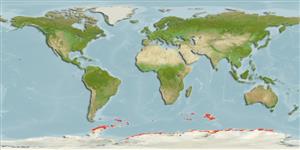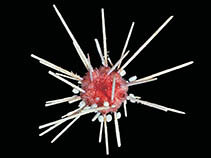Ctenocidaris nutrix (Thomson, 1876)
| Native range | All suitable habitat | Point map | Year 2050 |

|
| This map was computer-generated and has not yet been reviewed. |
| Ctenocidaris nutrix AquaMaps Data sources: GBIF OBIS |
Classification / Names Populärnamn | synonymer | CoL | ITIS | WoRMS
Echinoidea | Cidaroida | Ctenocidaridae
Environment: milieu / climate zone / djupintervall / distribution range Ekologi
; djupintervall 23 - 650 m (Ref. 89911). Polar
Distribution Länder | FAO områden | Ekosystem | Förekomster | Utplanteringar
Southern Oceans: South Orkney (Ref. 87340), Kerguelen and Heard islands (Ref. 89911).
Length at first maturity / Size / Weight / Age
Könsmognad: Lm ? range ? - ? cm
Life cycle and mating behavior Könsmognad | Reproduktion | Lek | Eggs | Fecundity | Larvae
Main reference
referenser | Koordinator | Medarbetare
Southern Ocean Mollusc Database (SOMBASE) 2011 British Antarctic Survey, SOMBASE. Accessed through GBIF data portal, http://data.gbif.org/datasets/resource/66, 2011-07-15. (Ref. 87340)
IUCN Red List Status
(Ref. 130435: Version 2025-1)
CITES status (Ref. 108899)
CMS (Ref. 116361)
Threat to humans
Human uses
| FishSource |
Verktyg
Ytterligare information
Födosammansättning
Födointag
Predatorer
Max. ages / sizes
Length-weight rel.
Length-length rel.
Length-frequencies
Mass conversion
Abundans
Internet-källor
BHL | BOLD Systems | CISTI | DiscoverLife | FAO(Publication : search) | Fishipedia | GenBank (genome, nucleotide) | GloBI | Gomexsi | Google Books | Google Scholar | Google | PubMed | Tree of Life | Wikipedia (Go, sök) | Zoological Record



